For the second time before his 26th birthday, Juan Soto is on the move. The Yankees and Padres announced a trade sending Soto and fellow outfielder Trent Grisham from San Diego to the Bronx. The Friars receive five players — right-hander Michael King, top pitching prospect Drew Thorpe, right-handers Jhony Brito and Randy Vásquez, and catcher Kyle Higashioka — in return.
Soto’s time in San Diego concludes after a season and a half. The Padres acquired the star slugger from the Nationals during the summer of 2022 in one of the biggest deadline blockbusters in history. He’d go on to appear in 214 games with the Friars, hitting .265/.405/.488. It wasn’t immediately the smoothest tenure, as Soto was hitting below his established lofty standards down the stretch in ’22 and early this past season. By May, he turned a corner and was back to performing at an elite level.
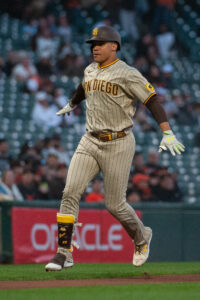
The three-time All-Star ultimately turned in a .275/.410/.519 line with 35 home runs while playing in all 162 games. He narrowly established a career mark in longballs despite the generally pitcher-friendly nature of Petco Park. Soto’s generational plate discipline remained on full display. Among hitters with 400+ plate appearances, only new teammate Aaron Judge walked more frequently. Soto trailed just the respective league MVPs, Ronald Acuña Jr. and Shohei Ohtani, in on-base percentage. He was one of four hitters to walk more often than he struck out.
It’s what we’ve come to expect from Soto, who now owns a .284/.421/.524 slash over five and a half MLB seasons. He’s on a Hall of Fame trajectory and will immediately step into the middle of the New York batting order. He and Judge now comprise the game’s most fearsome corner outfield tandem. Along with Grisham and Alex Verdugo — acquired last night from the Red Sox — they’re part of an almost completely overhauled outfield in the Bronx.
The trade is a firm win-now strike for the Yankees, the kind of headline-grabbing splash that’s reminiscent of the Bronx Bombers of old. It’s a bold push on the part of ownership and the front office after a fourth-place finish in the AL East.
In all likelihood, Soto is a one-year acquisition. He is in his final offseason of arbitration eligibility. MLBTR contributor Matt Swartz projects him for a $33MM salary that would break the all-time record for an arb-eligible player. While the Yankees are likely to inquire with Soto’s representatives at the Boras Corporation about a possible long-term extension, it is widely expected he’s strictly a one-year rental. The three-time All-Star rejected a $440MM offer from the Nationals prior to his trade to San Diego. The price would surely only be higher now that Soto is a season and a half closer to the open market.
The chance to discuss extension figures with Soto’s camp isn’t entirely without value, yet it’s far less important than ensuring he’ll be a Yankee in 2024. Manager Aaron Boone said this morning the Yankees were comfortable playing Judge in center field if necessary. The Athletic’s Ken Rosenthal thinks the team’s “most frequently used outfield” would indeed feature Judge in center despite the increased injury risk of that position, with Soto in right and Verdugo in left.
Given Giancarlo Stanton’s injury history, the Yankees should also be able to rotate their stars in the DH mix and use the glove-first Grisham in center. Top center field prospect Jasson Domínguez could factor in at some point later in the year after rehabbing from Tommy John surgery, while young left fielder Everson Pereira is likely to head back to Triple-A.
Grisham, who recently turned 27, played four seasons in San Diego. The Padres acquired him from the Brewers in a four-player trade after the 2019 campaign. Grisham had an excellent showing in the abbreviated 2020 season but has trended down offensively through the past few years. He was still a slightly better than average hitter in ’21 before falling below that in the last two seasons.
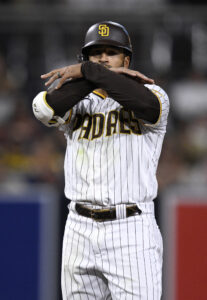
The left-handed hitter has run sub-Mendoza line batting averages in each of those campaigns. The Padres nevertheless stuck by him as their primary center fielder. Grisham has been patient enough to work a fair number of walks and reached double digits in homers for all four years in San Diego. His .191/.300/.347 line going back to the start of 2022 remains grisly, but the walks and serviceable power have been enough to make him a bottom-of-the-lineup regular.
Grisham is a plus defender in center field, annually receiving strong marks from Defensive Runs Saved and Statcast’s Outs Above Average. DRS has rated him 25 runs above average in his nearly 4100 career innings; Statcast has Grisham 30 runs better than par. The glove was enough for the Padres to tender him an arbitration contract projected around $4.9MM. Grisham will go through that process once more before qualifying for free agency after the 2025 campaign.
Between Verdugo, Soto and Grisham, the New York front office has added a trio of left-handed bats within a little more than 24 hours. Early in the offseason, general manager Brian Cashman called it a priority to bring in two lefty-swinging outfielders. There may not be one in the majors better than Soto.
It comes at the cost of a good chunk of their upper level pitching depth and significant cash. The Padres went into the offseason broadcasting a need to cut spending. The Friars had emerged as a surprising behemoth in recent years. Late owner Peter Seidler signed off on repeated sprees that pushed the Friars into the realms of the game’s top spenders. President of baseball operations A.J. Preller has never been shy about pursuing star talent.
That evidently hasn’t been entirely sustainable over the long haul. With reports of a need to scale back payroll toward the $200MM range to become compliant with MLB’s debt service ratio, speculation about a Soto trade has been rampant throughout the winter. He’d been projected for the highest 2024 salary of anyone on the roster. Yet the short-term commitment made it easier to move Soto for a noteworthy return than it would have been to shed money from a lengthy deal (e.g. Jake Cronenworth, Xander Bogaerts or Fernando Tatis Jr.).
With no intention to rebuild, the Padres needed to find a way to bring in rotation help. San Diego had arguably the sport’s best starting pitching last season. With each of Blake Snell, Nick Martinez, Seth Lugo and Michael Wacha hitting free agency, they were down to essentially Joe Musgrove, Yu Darvish and a host of unproven options with limited payroll room.
The Yankees obliged, sending a handful of upper level arms. The package is headlined by King, a 28-year-old righty who broke out as a starter late last season. The Boston College product had been an effective multi-inning reliever for the bulk of his time in the Bronx. Reeling with rotation issues late in the year, the Yankees gave King a shot as a starter. They couldn’t have anticipated it going as well as it did.
In his nine starts, King pitched to a 2.23 ERA through 40 1/3 innings. He held opponents to a .243/.284/.355 line while striking out a stellar 31.3% of batters faced. The Yankees gradually built his workload, keeping him to five or fewer innings in all but two of those appearances. King found success in both outings he did work into the sixth, each against the Blue Jays, highlighted by a 13-strikeout performance on September 20.
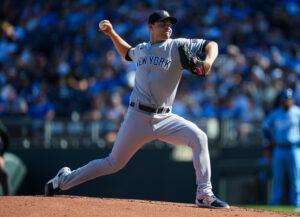
There’s certainly risk in betting on King to hold up as a starter. This year’s 104 2/3 innings is a personal high at the MLB level, plus King was on the 60-day IL in 2021 and ’22 for a finger injury and an elbow fracture, respectively. The Padres hit on their gamble that Lugo could convert from the bullpen last offseason, though. King held his 94-95 MPH average fastball velocity and mixes four pitches. He has dominated hitters from either side of the plate and owns an overall 2.60 ERA with a 30.6% strikeout rate in 155 2/3 frames since the start of 2022. It’s a gamble, but there’s also significant upside.
The Padres control King for two seasons via arbitration. His earnings have been capped by his career résumé as a non-closing reliever. Swartz projects him for just a $2.6MM salary in 2024. Even if he performs well over a full season as a starter, he’d likely be capped in the $8-10MM range for ’25.
Brito and Vásquez held depth roles in the rotation as rookies in 2023. The former is a 25-year-old righty who worked 90 1/3 innings over 25 outings (13 starts). Brito pitched to a 4.28 ERA overall but fared much better out of the bullpen. He turned in a 1.43 ERA with a solid 24.3% strikeout rate in relief compared to a 6.32 mark with a 16.4% strikeout percentage from the rotation. That could point to a future in long relief, although prospect evaluators generally projected Brito as a possible back-end starter.
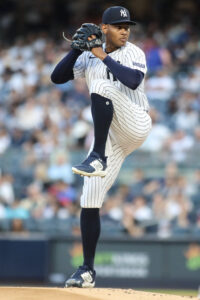
Vásquez, 25, posted a 2.87 ERA through his first 37 2/3 MLB frames. His strikeout and walk numbers were more middling. Vásquez also struggled to throw strikes in Triple-A, although he punched out nearly 27% of batters faced in 17 starts at the top minor league level. His fastball sits in the mid-90s and he mixed six pitches (four-seam, sinker, cutter, sweeper, changeup and curveball) in his limited big league time.

Both hurlers still have two minor league options remaining. Neither has yet reached a full year of service. San Diego can control them for at least six seasons. They’re each reasonably valuable trade pieces, but Thorpe is the true secondary piece behind King.
A second-round pick in 2022, the 6’4″ righty was excellent in his first full professional season. Thorpe combined for a 2.52 ERA in 139 1/3 innings between High-A Hudson Valley and Double-A Somerset. He punched out more than a third of batters faced compared to a modest 7.1% walk rate. Baseball America had recently ranked him seventh among Yankee prospects.
According to BA, he sports a deep arsenal headlined by a plus changeup and good life on a 92-94 MPH fastball. He also has plus control and projects as a back-end or better starter. He’ll likely start the season in Double-A, but as an advanced college draftee, it’s not out of the question he’s on the mound at Petco Park sometime next summer. Preller suggested as much in a post-trade press conference this evening.
Rounding out the return is Higashioka, a veteran catcher to back up 25-year-old Luis Campusano. Higashioka had spent a decade and a half in the Yankee organization dating back to his selection in the 2008 draft. He has settled in as a respected #2 presence behind the dish. Higashioka runs bottom of the barrel on-base grades but has reached double digit homers in three straight seasons. He has excellent pitch framing marks throughout his career, although Statcast metrics suggest his typically solid blocking ability plummeted this year.
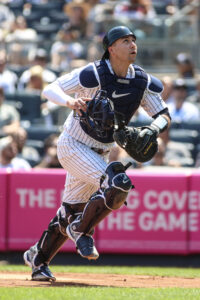
Swartz projects the 33-year-old for a $2.3MM salary in his final season before free agency. With no cash considerations involved in the swap, the financial elements of the trade are limited to the players’ respective arbitration salaries. King and Higahioka are projected to make a total of $4.9MM; Soto and Grisham will combine for something in the $37.9MM range.
It represents around $33MM in savings for the Padres. Roster Resource projects the Friars around $156MM in actual spending. They’re at roughly $209MM in luxury tax commitments, around $28MM below the base threshold. There’s room for the front office to dip into the middle tiers of free agency. They’ll likely still look for some reliability in the back of the starting staff, a back-end reliever and add at least one outfielder. Tatis could theoretically slide from right to center field, although it’s widely expected they’ll pursue KBO center fielder Jung Hoo Lee. Additionally, Preller stated his intention tonight to look to add more starting pitching.
The cost for the Yankees goes well beyond the $33MM difference in arbitration projections. The Yankees were already into luxury tax territory. Roster Resource now projects their CBT mark in the $290MM range, well into the third tier of penalization. The Yankees have paid the tax in each of the last two years, so they’re charged significantly higher penalties as repeat payors.
New York will pay a 50% tax on spending between $237MM and $257MM, 62% on their next $20MM, and 95% for spending between $277MM and $297MM. They’d be taxed at a 110% rate on every dollar past $297MM. The Yankees pretty clearly still need to add a starting pitcher and perhaps a reliever, and it’s worth considering that the cost of those additions would roughly double in 2024 due to the luxury tax – barring payroll subtractions in other places.
In total, today’s trade adds around $24.75MM in expected tax obligations. It amounts to a nearly $58MM investment for what’s primarily one season of Soto’s services and two years from Grisham. The Yankees could recoup a draft choice if Soto walks in free agency next year once he declines a qualifying offer, although that’d fall only after the fourth round because of New York’s CBT status.
Between the huge financial cost and the notable pitching talent, it’s a massive investment. That’s a testament both to Soto’s talent and the Yankees’ all-in approach to turning things around. It will likely be the biggest trade of the offseason and, unlike some blockbusters, it’s between two clubs that fully expect to compete for a playoff spot in 2024. Things are just beginning for both franchises.
Jack Curry of the YES Network reported this morning that a Soto trade was likely. MLB.com’s Jon Morosi reported the Padres would receive King, Thorpe and at least two others. Joel Sherman of the New York Post confirmed Grisham’s inclusion. Curry had the likely inclusions of Vásquez, Higashioka and Brito. Sherman first reported the deal was agreed upon.
Images courtesy of USA Today Sports.
